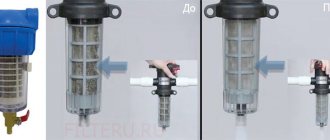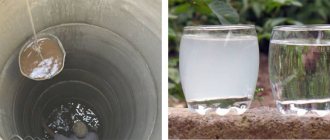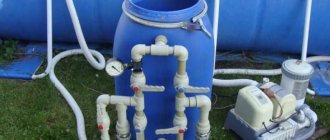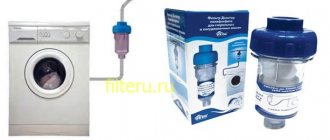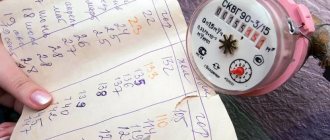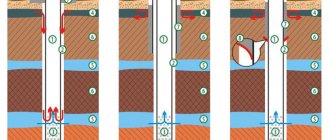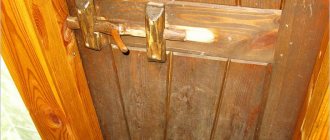Has the water in your well become dirty and its smell leaves much to be desired? Agree, such water is not only unpleasant to use as drinking water, but also very dangerous. After all, the microorganisms it contains can lead to various diseases.
Are you planning to disinfect a source, but don’t know how to do it correctly? We will help you understand the intricacies of this process and tell you what tools you can use. We have described in detail a set of measures aimed at eliminating unpleasant odors and pollution.
We present effective compounds used for disinfection, present thematic photos and videos with valuable recommendations. Proper and timely disinfection of water in a well, carried out according to our advice, will allow you to safely use it for drinking, household needs and irrigation.
Actions after disinfection is completed
After completing the disinfection procedure, which was carried out using chlorine-containing products, it is recommended to follow the following recommendations:
- Do not use well water for the first 24 hours after disinfection is completed.
- For 5-10 days, it is necessary to boil and/or pass water from the well through a filter before use.
- If there is a smell of chlorine in the water, then it is necessary to completely pump the well.
After all these steps, it is advisable to conduct a chemical analysis of well water to assess the quality of purification and confirm its safety.
For a more thorough analysis of water from a well, a visual inspection is not enough; it is necessary to study the chemical composition in the laboratory.
Areas of application of bleach
Due to its wide spectrum of action, bleach can be used in almost any industry.
The main properties of this multifunctional substance include:
- Antiviral
- Whitening
- Bactericidal
- Antiseptic
- Insecticidal
- Anthelmintic
With this set, hypochlorite has gained popularity in widespread use, and the only disadvantage can be called only the acrid unpleasant odor of all chlorine-containing substances.
Household needs
At home, bleach replaces a large number of all kinds of cleaning products. It is used to disinfect an apartment after an illness or suspicion of a virus. Bleach also stops the spread of fungus and completely destroys it. In private homes, mold treatment in basements, greenhouses and other utility rooms is especially important.
INFORMATION:
Water and drainage treatment
Bleach has long been used to disinfect tap water and clean swimming pools. Wells are also treated with it, which helps avoid the spread of various infections. Of course, other methods are used to purify water, but only in parallel with chlorination. Chlorine is also indispensable for cleaning filters and piping systems. For this purpose, solutions of sodium or potassium hypochlorite, bleach, chloramine, as well as a gaseous form of chlorine are used.
Given the toxicity of the substance and its unpleasant aroma, it is important to strictly follow the dosage. It depends on the version of the active substance - they have different concentrations of chlorine
Therefore, you need to follow the attached instructions. So, to chlorinate private swimming pools, you can use white (at the rate of 1 liter for every 10 cubic meters of water). But there are other parameters that cannot be ignored:
- The medium must be slightly acidic (ph = 7.2−7.6), otherwise a strong odor cannot be avoided.
- It is advisable to dilute in cool water.
- The recommended interval between chlorination and the start of using the liquid is at least 20 hours.
Public places
Disinfection is most often carried out in order to reduce the possibility of the spread of infection or prevent the occurrence of a viral disease. However, in high-traffic areas, disinfection is a mandatory and regularly performed action; in these cases, disinfection can be considered a preventive measure.
The main objects that are treated daily with bleach are:
- Educational institutions: kindergartens, schools, technical colleges, universities
- Places with large crowds of people: train stations, cafes, shopping centers, cinemas, theaters
- Medical organizations: clinics, hospitals, medical centers
- Sphere of cosmetology: beauty salons, hairdressers
Hypochlorites in medical practice
Sodium hypochlorite exhibits pronounced anti-putrefactive properties, therefore, in the form of a solution, it is used in medicine for treating skin, mucous and wound surfaces. Sometimes the solution is administered by injection. It is also used to combat most bacterial and viral microorganisms, parasitic fungi, as well as some types of protozoa. It effectively eliminates the most dangerous pathogens, such as the causative agents of herpes, tuberculosis, hepatitis, typhoid, anthrax and even AIDS. We will use the solution in various areas of medicine.
It is noteworthy that sodium hypochlorite eliminates not only active pathogenic organisms, but also their spores. Because both sodium and potassium salts of hypochlorous acid (hypochlorites) are used to treat medical products, dishes, furniture, linen, floors and walls, bathrooms, etc. These products have strong corrosive properties, which must be taken into account when disinfecting instruments and metal equipment.
Disinfecting qualities of chlorine
Restaurants and meat and poultry processing plants use chlorine bleach and other chlorine-based products to kill harmful levels of bacteria, such as salmonella and E. coli, on food preparation surfaces and during food handling.
Chlorine is so important in poultry processing that the USDA requires almost constant chlorine flushing on most cutting equipment. In fact, there is no proven economic alternative to chlorine disinfection for use in meat and poultry processing plants.
Preparation for disinfection treatment
It is recommended that preparatory work be carried out immediately before the disinfection procedure. The speed and quality of disinfection treatment largely depends on the correct preparation.
First of all, it is necessary to pump out the water. If there is little water in the well, then it will be enough to use a surface pump.
If the water level is significant, then a powerful submersible pump will be required. Before starting the pump, you need to remove floating debris from the well; a long-handled net with a fine mesh is best suited for this purpose.
After pumping out the water, they descend into the well and inspect its bottom and walls for cracks, leaks, and deposits. If there are cracks, they must be eliminated with a special waterproofing solution. Debris, algae, and silt are also removed from the walls of the well.
Image gallery
Photo from
Poor quality of well water
Cleaning the well yourself
Repairing walls before disinfection
Checking the composition of water for acidity
The tools used are stiff brushes and spatulas. The bottom of the well is cleared of sediment, the old bottom filling is removed as far as possible and a new one is filled in.
Fine crushed stone, gravel, and sand can be used as bottom fill. Expanded clay cannot be used due to its too low specific gravity and high toxicity.
If there is plaque on the concrete rings, it should also be removed. For this, various substances are used, the composition of which depends on the nature of the deposits. Salt deposits are removed with acid-containing solutions, such as a weak solution of hydrochloric acid or vinegar.
It is recommended to carefully remove corrosion stains using a jackhammer or grinder, and treat the surface with a waterproof anti-corrosion compound. If moldy deposits are present, treatment with copper sulfate is required.
Before the disinfection procedure, it is necessary to thoroughly clean the shaft and the bottom of the well from debris and various deposits, using special means
Well cleaning
So, let's take a closer look at how to get rid of the smell of water in a well. At least once a year it is necessary to carry out preventive water cleaning. Thanks to this, it will be possible to avoid many problems with water supply, and therefore with health. If you don’t do this, mucus may appear quite quickly. It is this area that provides a haven for the rapid proliferation of harmful bacteria. In addition, debris and silt may settle at the bottom of the well. Because of this, the quality of well water deteriorates.
The procedure consists of several stages:
- Disinfection using special preparations. Use strictly in accordance with the instructions in the attached instructions.
- Water is pumped out using a pump.
- The well is cleaned of various deposits using a mechanical method, that is, with your own hands.
Measures to prevent source pollution
In order to carry out disinfection measures as rarely as possible, but at the same time use high-quality water, it is necessary to follow a number of measures aimed at preventing contamination of the well.
Such measures include the following:
- the well must not be left open;
- maintain a distance of at least 20 meters from the well to the sewerage and drainage system;
- reliably seal the walls of the well, preventing the penetration of groundwater;
- use submersible pumps with remote injectors, this significantly reduces the number of leaks;
- Observe sanitary standards and do not pour waste into the well.
Following these simple measures will avoid clogging and silting of the well, which are the most likely causes of deterioration in water quality.
Timely preventive disinfection will allow you to keep the well in the required sanitary condition and will make it possible to safely use water from it for various household needs.
Disinfectants
Disinfection of water in a well is carried out using special agents that have antibacterial and disinfecting properties.
They must have the following properties:
- effectively eliminate pathogenic microorganisms and suppress their development
- be safe for the human body
- do not damage the walls of the well
- easy to wash off.
Most often, compounds are used to disinfect well water and mines, which we will discuss in more detail in the next part of the article. To pump out water that has undergone a disinfection procedure, it is better to use an inexpensive pump, which you won’t be sorry to part with after use.
Remedy #1 - Effective Bleach
You can buy 1% chlorine powder at any hardware store.
To accurately calculate the amount of bleach, the following experiment is carried out:
- take 10 g. bleach and dilute in 1 liter of clean water;
- take 3 containers of 200 ml each and fill them with water from the well;
- add 2 drops of chlorine solution to the first container, 4 drops to the second, 6 drops to the third;
- stir the water in all containers and wait 30 minutes;
- After the time has passed, we check each container for the presence of chlorine odor - it should be barely noticeable.
Considering that 1 ml of bleach solution contains 25 drops, we find that to disinfect 1 cubic meter of well water, 400 ml of solution is needed. Knowing the volume of water in the well, it is easy to calculate the need for a chlorine solution required for the disinfection procedure.
Disinfection instructions:
- Pour the solution into the well and stir the water in it for 10 minutes using a long pole or brush. If the volume of the well is large, then it is advisable to use a bucket on a rope for mixing, which scoops up water and then pours it back.
- We cover the well with plastic film or thick cloth for 6-10 hours in the summer or for 12-24 hours in the cold season. It is important to prevent direct sunlight from entering the well, under the influence of which chlorine breaks down, significantly reducing the effectiveness of disinfection.
- If, after the specified time, the smell of chlorine is completely absent in the well, then disinfection should be repeated, because this indicates the destruction of the chlorine compound and the low effectiveness of disinfection measures.
- We wash the walls of the well first with chlorinated water and then with clean water.
- We pump out the water until you smell chlorine.
When using bleach, you must strictly observe safety precautions, avoiding contact of the solution with skin, plastic and metal surfaces.
A chlorine solution must be prepared only using cold water; warm water makes the chlorine compound volatile and very dangerous for the respiratory system.
Remedy #2 - affordable “Whiteness”
Another inexpensive way to quickly and efficiently disinfect a well. It was experimentally established that the optimal water level is per 1 reinforced concrete well ring.
The disinfection technology is exactly the same as when using bleach: the solution is poured into a well, the walls are washed with a brush, a long brush, or just a rag wrapped around a pole.
Sometimes special garden sprayers are used to apply chlorine solution or “Whiteness”. This simplifies the procedure for cleaning the walls of the well, but do not forget to thoroughly rinse the equipment after finishing work.
To disinfect a well, you can use any chlorine-containing products in the form of liquid or powder, sold in hardware stores.
Remedy #3 - quick and safe potassium permanganate
This method of disinfecting a well is gentle, but its effectiveness is significantly inferior to the chlorine method. However, in some cases, potassium permanganate (potassium permanganate) can be used to disinfect the mine and water in the well.
To prepare the solution, take 1 tablespoon of potassium permanganate per 10 liters of warm water. The solution is thoroughly mixed and poured into the well. Leave the solution for 30-60 minutes and pump out the water several times.
After completing the cleaning, the dry walls of the well are washed with a solution of manganese, and a mesh (ordinary sieve) with 3-5 grams of manganese is placed at the bottom, which will remain there constantly, providing a disinfecting and antibacterial effect. Instead of manganese, you can put silicon chips on the bottom, which also has disinfecting properties.
Remedy #4 - iodine solution as an emergency measure
Experts have different opinions regarding this method of disinfection. Some believe that iodine is an excellent antibacterial agent that destroys pathogenic microorganisms and the environment that prevents their proliferation.
Others say that the required bactericidal concentration will make well water unsuitable for drinking and irrigation.
In any case, disinfection with iodine can be used in cases where it is not possible to completely disinfect the well. To do this, you need to prepare a solution - 3 drops of iodine per 1 liter of water (3-5 liters of water is enough for 1 reinforced concrete ring) and pour it into the well. This measure will help slightly delay the cleaning of the well and improve the quality of the water.
Do not pour dry potassium permanganate powder into the well - this can lead to undesirable chemical reactions and the formation of heavy compounds
Remedy #5 - tablets
The modern market for household chemicals offers a convenient option for disinfecting wells - chlorine-containing tablets "Aquatabs" , "Septolite" , "Ecobreeze" and others.
The average consumption of such tablets is 4 tablets per bucket of water for one well. The exact dosage is given by the manufacturer in the instructions for chlorine tablets. To prepare solutions, use a plastic or enamel bucket; water is taken at room temperature.
The disinfection procedure is carried out in two stages:
- Preliminary stage. Water is pumped out of the well, the bottom and walls are cleaned of dirt and sediment. After this, the walls are irrigated with the prepared solution; for this you can use various spray devices or simply a rag on a pole or a brush. After applying the composition, you need to wait 30 minutes and then rinse the walls with clean water.
- Water disinfection. The well is filled with water and the solution obtained by dissolving chlorine tablets is poured into it. The number of tablets depending on the volume of the well is also indicated in the manufacturer's instructions.
To disinfect, the water in the well is mixed with a disinfectant composition, and the well is tightly covered with polyethylene or thick cloth. Aged from 3 to 12 hours. After this, it is necessary to pump out the water until the smell of chlorine disappears completely.
The use of tablets in comparison with bleach and bleach has the following advantages:
- high efficiency of cleaning and disinfection;
- ease of use, ease of preparation of the solution;
- shorter residence time of the solution in the well;
- safety of use.
The disadvantages of chlorine tablets include their high cost.
Tablet products must be used strictly in accordance with the manufacturer’s instructions, without exceeding the recommended dosage, in order to avoid poisoning the water in the well.
Cleaning systems for private homes and cottages
It is rare to find sources that require one type of filtration. Complex solutions are used for water treatment.
Rough cleaning
In water purification systems, liquid enters from a well after mechanical filters made of fine mesh.
Gravity circuit
Liquid purified by inlet filters is supplied from the well to the system.
A float switch for the pump prevents overflow. For the same purpose, a drainage hole with a discharge into the sewer is installed in the upper part.
The volume of the container is chosen depending on the number of people living in the house. According to sanitary standards, each person consumes (spends) 200 liters per day. Up to 30% of the tank capacity goes into drainage after filtration.
Calculation example. A family of three requires 600 liters per day. 300 liters after settling will go into drainage. In total, for uninterrupted water supply to families, a capacity of 1 m3 is installed.
System operation. Liquid is drawn into the tank from the well.
Installing a compressor accelerates oxidation. The non-compressor method increases the oxidation time, but it is also effective.
The pumping station maintains the set pressure in the water supply pipes.
Liquid is withdrawn through tap 1, installed in the lower third of the container.
Through tap 2, water containing metal deposits that fall out in the form of flakes is removed.
By combining the positions of the taps, they regulate the direction of flow: clean water goes into the house, dirty water goes into the drainage.
Fine cleaning
The purpose of the equipment is to saturate the liquid with oxygen, which converts divalent iron into ferric iron. It is subsequently removed by filtration.
Manganese and aluminum salts are removed in a similar manner.
Aeration systems can be either non-pressure or pressure.
Pressure system
The pressure device includes a column and a compressor that forces air into a special mixer as a stream of water passes through it. Switching on is controlled by a fluid flow sensor.
A valve is installed in the upper part to bleed off excess air. Increased mixing of the mixture throws water into the valve, so the outlet pipe is connected to the sewer.
The pressure cleaning system justifies its purpose when the iron content is 20-30 times higher. The equipment covers the cost of purchasing and paying for the electricity consumed by the compressor by reducing the cost of new filters.
After pressure and non-pressure systems, additional equipment is installed.
Reverse osmosis
The service life of the membranes is no more than 5000 liters. Consequently, for daily complete purification of water in a country house, the capabilities of such a device are limited.
A washing machine consumes from 40 to 60 liters per wash cycle. A dishwasher will require up to 20 liters. A shower for one person will cost 40-50 liters. Thus, a consumption of 200 liters per person accumulates per day.
A family of three will use up a reverse osmosis membrane in 10-15 days. In addition to the cost of the membrane itself (from 900 to 2500 rubles), the labor costs for replacement are taken into account. You can do the procedure yourself if you have the skills and experience. Errors may result in the leakage of connections, thread breakage and the need to replace the kit.
Cleaning from bacteria and viruses is carried out with ultraviolet light.
How to remove lime
If a laboratory analysis shows an increased calcium content in the water, you will have to solve this problem.
When permissible standards are several times higher, ion exchange filters are used. The equipment consists of a tank filled with ion exchange resins of natural or synthetic origin. Additionally, you will have to install a regeneration tank with a salt solution for periodic washing of equipment and resin.
Septic tanks with soil treatment
A cheap, simple and advanced analogue of concrete wells are plastic septic tanks with soil purification. They usually look like barrel-shaped tanks with lids. When choosing a factory septic tank, you should take into account the number of tanks, volume and number of chambers in them. So, with a consumption of 1 cubic meter of water per day, a single-chamber tank is sufficient, with a consumption of 5 cubic meters per day - a two-chamber one, and with a consumption above 8 cubic meters per day - a three-chamber one. The more compartments, the better the quality of wastewater treatment.
Multi-chamber installations provide wastewater treatment for subsequent discharge into ditches
How it works? In the three-chamber model, wastewater first enters the first chamber, and the heavy fractions sink to the bottom. After some time they turn into sludge. Light particles, along with water, enter the second chamber, where they are processed by bacteria. The purified composition is pumped into the third chamber. There, a filter and a special antiseptic mesh with colonies of bacteria await him.
Next, 60-70% purified water enters the filtration field, which is a trench with crushed stone in which perforated pipes or an infiltrator are laid. Here, wastewater is further purified by aerobic bacteria, after which the liquid is drained into a drainage ditch. An integral part of such a treatment system is ventilation pipes (they are needed for air access and maintaining the vital activity of aerobic bacteria).
This is what a septic tank looks like with soil post-treatment in the form of a multi-chamber installation and a filtration field with perforated pipes
What are the benefits of such septic tanks? Due to the fact that the water obtained after cleaning can be poured into drainage ditches (but cannot be used for irrigation or drinking!), the system does not require energy sources for full operation, and the container needs to be cleaned no more than once every 1-3 years.
For a family of 2-3 people, a single-chamber septic tank with a production volume of several cubic meters is sufficient.
The disadvantages of septic tanks with soil post-treatment are:
- inability to use purified water for drinking and irrigation;
- within a radius of 3 m from the filtration field, you cannot grow vegetables or plant fruit trees and shrubs (for a small area this can play a fatal role).
It should also be remembered that in areas with heavy soil or high groundwater levels, such a septic tank will not “work”. For the system to function, you will have to install an additional container with a drainage pump and build a special dome for additional water purification on the soil surface. It will turn out to be very expensive and ineffective.
Thus, wastewater still remains a serious headache for private home owners. There are not many purification methods after which the recycled water can be drunk, and they are not cheap. It’s easier to dispose of wastewater in small doses using modern environmentally friendly technologies.
How to clean and disinfect blooming water
Water blooms are caused by blue-green algae. This type of water is the most difficult to purify. Some of these algae are capable of producing toxins hazardous to human health.
The method of purifying water from toxins is the same as for other “chemical” contaminants: filters with activated carbon, followed by disinfection from bacteria and other microorganisms.
Boiling
In this case, boiling water is simply necessary! At a temperature of 70C, most microorganisms die within 30 minutes, at temperatures above 85C - within a few minutes.
Boiling is a very reliable method, but in extreme conditions it may not be very convenient.
Potassium permanganate (potassium permanganate, KMnO4)
To purify water using potassium permanganate, you need to add a couple of crystals of the substance to 3-4 liters of water. The water should acquire a light pink tint (a bright color is unacceptable, such a solution can be harmful to health).
The advantages of this method of water disinfection are: high efficiency, low cost, compactness and low weight. KMnO4 is a strong oxidizing agent, therefore it not only destroys bacteria, but also neutralizes a number of toxins (waste products) released by these same bacteria. However, today, potassium permanganate is extremely difficult to find in pharmacies.
Iodine
The method is emergency, but in a critical situation it can help, since iodine can be found in almost any first aid kit.
The disinfection method is simple: add 10-20 drops of a 10% alcohol solution of iodine to 1 liter of water (less is possible, but this dosage may not be effective enough). The amount of iodine must be determined visually, based on the degree of water contamination.
Iodized water should be allowed to stand for 20-30 minutes in the summer, an hour or more in the cold season. To ensure the destruction of especially tenacious and dangerous bacteria, a longer time is required (up to 4 hours).
This water is not very healthy and tastes unpleasant. To get rid of the iodine taste, it is recommended to pass the water through a carbon filter or add activated carbon to it (the latter is less effective). You can also crumble ascorbic acid into water (iodine easily oxidizes it).
Hydrogen peroxide
Another popular way to disinfect water is to use hydrogen peroxide for this purpose. This is also an “emergency” method of disinfection. Hydrogen peroxide can disinfect water from protozoa (giardia and cryptosporidium), bacteria, and viruses.
Directions for use: add one tablespoon (if heavily soiled - 2 tablespoons) per liter of water, let stand for 1 hour. To clean the water from residual peroxide, as well as to speed up its breakdown, add a couple of tablets of activated carbon to the water.
The advantages and disadvantages of this method are the same as for other medications - you have to dose “by eye”. Despite the breakdown of hydrogen peroxide, the water may have a slight "medicinal" taste.
Salt
It can be used if no other reagents are available. It is enough to dissolve a tablespoon of salt in 2 liters of water. The solution is left for 30 minutes.
Enjoy your hikes and have bright, positive impressions!
Physical methods of disinfection
Modern methods of disinfecting well water include ultrasonic and ultraviolet cleaning . Both methods are highly effective and environmentally friendly, but their implementation requires the installation of expensive equipment.
It is advisable to install such equipment if water from the well is used in the autonomous water supply system of a house with year-round residence.
The UV cleaning device is equipped with an electronic unit that automatically regulates the water supply to the cleaning unit. The emitted ultraviolet destroys all known microorganisms without changing the taste, smell and color of water.
Equipment to perform UV disinfection is expensive. Therefore, it is rare that a summer resident chooses such an installation as an option for disinfecting water in his well.
In addition to the high cost of equipment, this method has another drawback: if the well is open, there is the possibility of secondary contamination of the water.
Ultrasonic cleaning uses equipment that emits ultrasonic waves, which are also harmful to microorganisms.
Of course, these disinfection methods are considered the most advanced and safe, but their use in most farms is not yet possible due to the high cost and inadequacy of wells.
